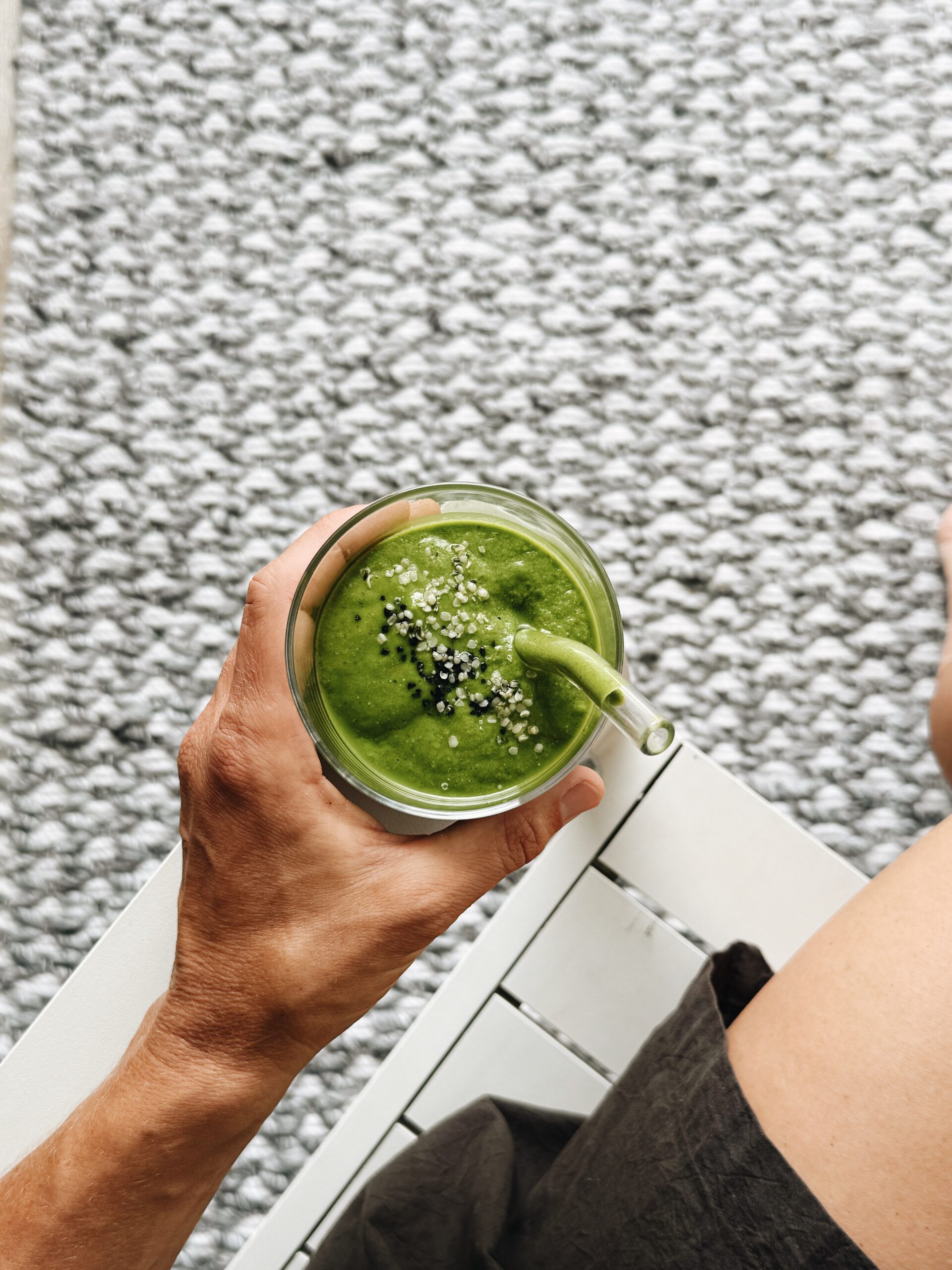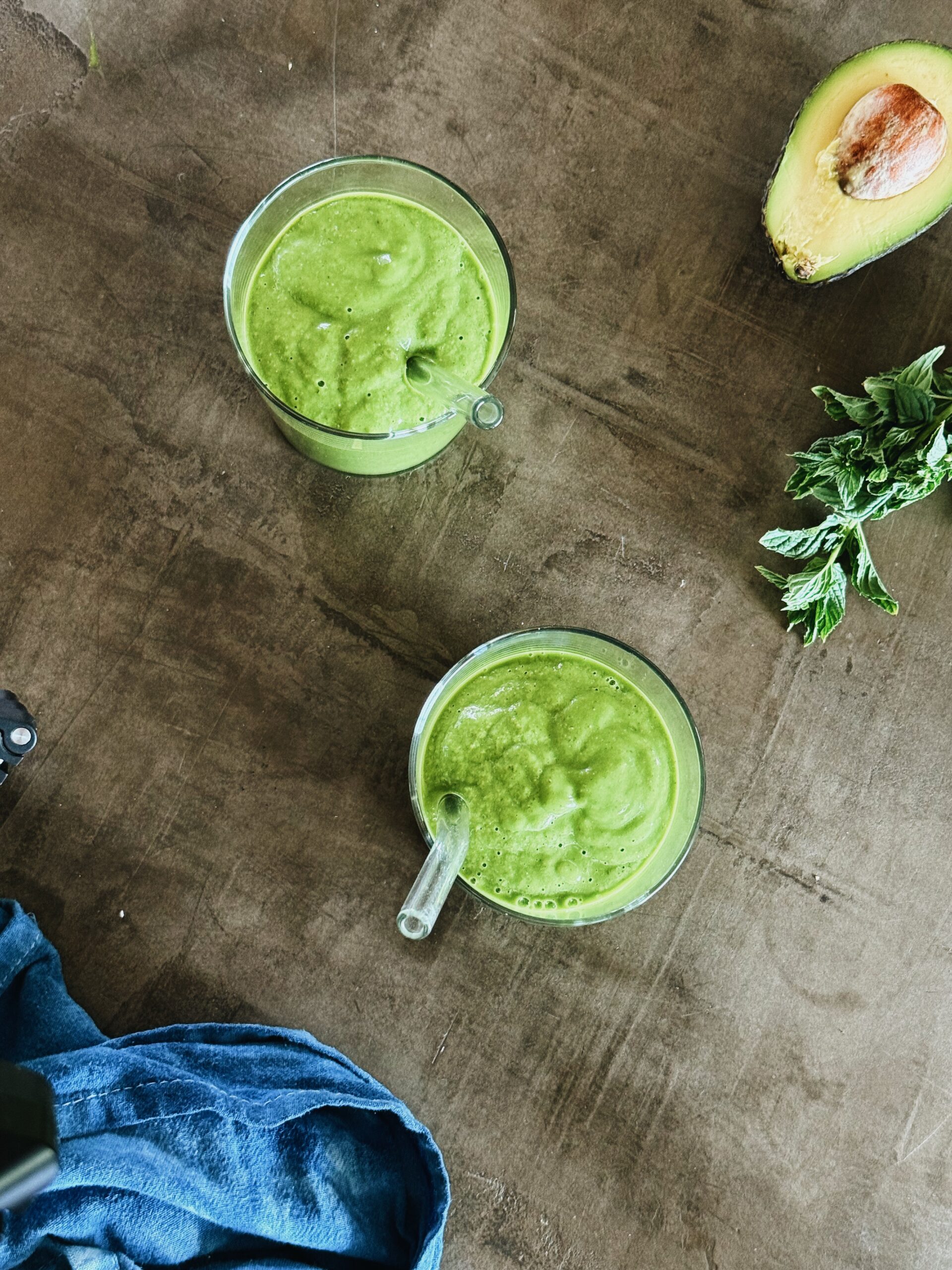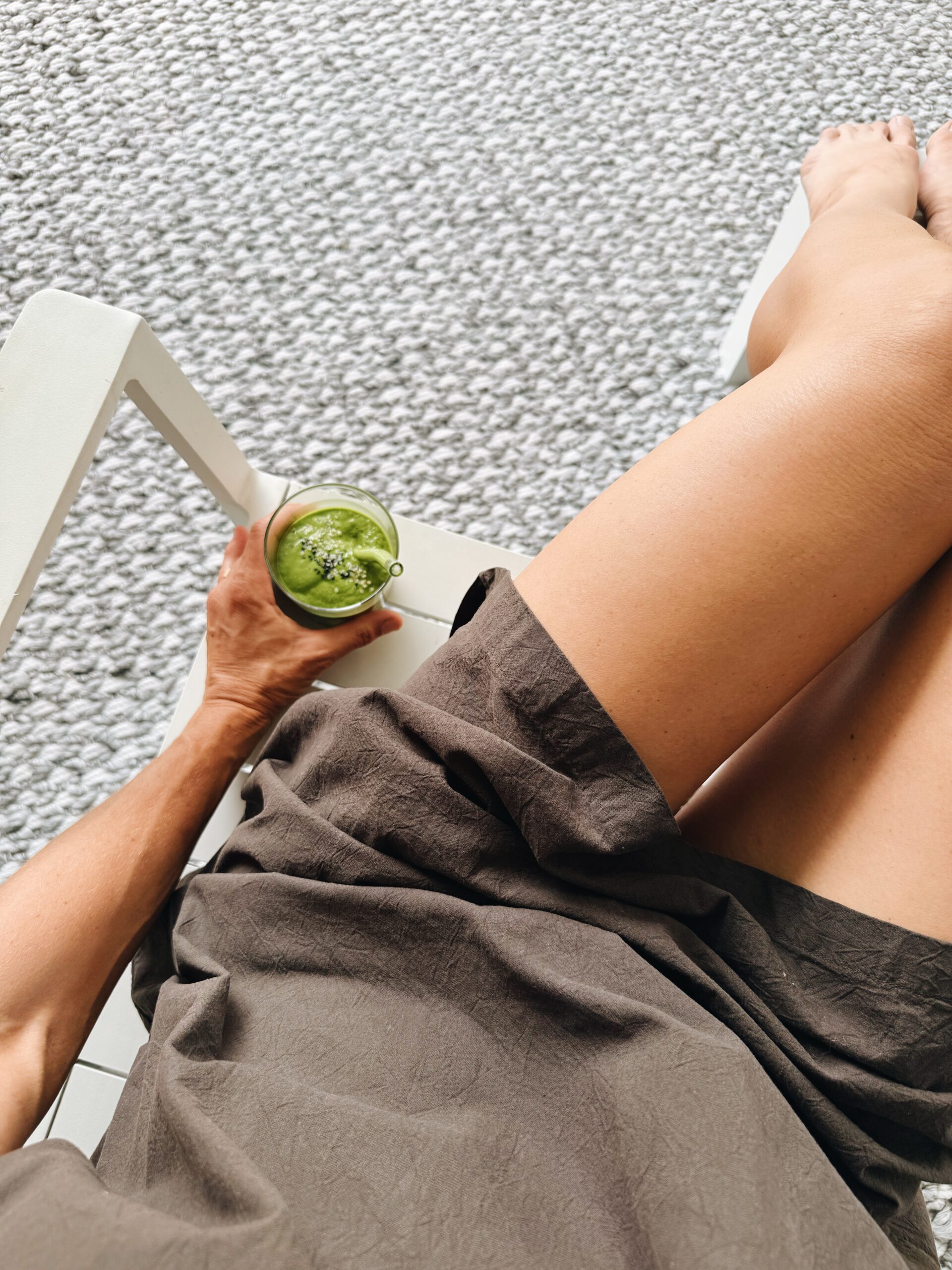

I would say that 90% of my new clients have a couple of things in common.
First, they suffer from bloating on a pretty regular basis.
And second, they loooooove to have smoothies.
Our first orders of business, then, when we start working together is to help them eliminate that uncomfortable bloat and I teach them why they need to learn to make a smoothie that will actually serve them, or tell them to abandon them all together. Most of them choose the former. And that’s where this Green Light Smoothie comes into play.

I distinctly remember a time when getting a “Jamba Juice” from our local grocery store was a routine occurrence. And I distinctly remember this healthy habit leaving me feeling like I had a balloon in my gut every time. I didn’t think much of it then, but now that feeling is absolutely unheard of — something I’ll avoid at all costs, and luckily something that very very rarely happens. Mostly because I stopped drinking ice cold fruit-and-protein concoctions that acted like gut bombs.
The conventional, modern smoothie is a bloating nightmare waiting to happen, my friends. Here’s why.
First, everything we consume needs to be warmed to 98.6°F so that we can digest, metabolize and assimilate it. When we drop something ice cold in the gut, it’s like throwing a bucket of water on the fire. That fire goes out. And turns out we have to have it burning bright to metabolize anything at all.
Second, when we consume fresh, juicy fruits (which are quick to digest) with slower-to-digest foods (like proteins and fats,) the fruits get overcooked in the digestive system. Turns out that our bodies don’t release foods that are “done digesting” further into the gut until the entire bolus – all of the food that we eat at one time — is done. Because of the high sugar content of the fruit, this means that those gorgeous natural sugars mixing with the stomach acids start to ferment in the gut — like a fine wine but not that fine, ya know. This is where the bloating, high acid, smelly farts come from that ensue after eating those fruits with the protein. (You can blush if you want. I know it’s happening.)
Thirdly, as if the bloating and discomfort of fermenting fruit in your gut isn’t enough reason not to enjoy a smoothie, your microbiome is threatened by the fermentation. Our microbiome, the trillions-strong ecosystem that’s responsible for managing most of our bodily functions (to include respiration, circulation, nervous system function, and digestion) require a specific pH to exist. Think of it a bit like a garden. Healthy plants need healthy, nourishing soil that isn’t too acidic or basic. When we allow “bad food,” or over-fermented food to pass through this system, it changes the pH in the gut, making our guts a much less enjoyable place to reside. And so, your immunity, nervous system, hormone function and metabolism all suffer.
Le sigh.
A smoothie looked cute and harmless and healthy enough, right? So so wrong.

Quick reminder here: there are no GOOD foods and BAD foods. All foods can be beneficial or harmful, depending on the context from the perspective of Ayurveda. And so the question of whether or not a smoothie is “good” or “bad” has everything to do with how you’re making the smoothie…
Cooling, refreshing beverages are not innately bad. (Though, Ayurveda would argue that ice cold ones aren’t doing us any favors because of that thing about how they ice down our digestive fire. No bueno.)
But if we’re mixing fruits, and proteins, and fats in a blender, chances are this is not great.
I like to think of supportive smoothie construction like this: if you’d eat all of the ingredients in a bowl with a spoon, chances are it will feel really good putting it into your body. And if not, then….probably steer clear.
There is no shred of desire in my body to eat a lab-made protein powder, with ice cubes, plant milk, leafy greens, frozen fruit, and some other weird supplements in a bowl with a spoon. Hard pass, from me and my very healthy digestive system.
I get this question ALL. THE. TIME.
Here’s the deal; every food that we eat causes our blood sugar to rise a bit – that’s the nature and purpose of metabolizing food. A “spike,” however, is a very substantial elevation (a rise in blood glucose of more than 30–40 mg/dL within 1 to 2 hours after eating, and/or when glucose levels rise above 140, especially if they hit 160–180 mg/dL or higher,) and they happen when we eat foods that have very high glucose indices, AND when foods are digested either too quickly, or too slowly. And this happens when the microbiome and when our digestive fire is imbalanced – NOT because we eat something that “spikes our blood sugar.”
Put another way – a blood sugar spike isn’t a problem with the food. It’s a problem with the system that digests the food.
When we skip meals, snack and graze, drink ice cold smoothies that ice down digestion (ahem,) eat and excess of cold and raw foods (read: salads) and consume an excess of caffeine, we deeply impact the health of the microbiome, and also the strength of our digestive fire. A weak digestive fire is unable to adequately metabolize foods of all kinds – high glucose and not.
Let’s think about these tiny microbes that live in our guts for a minute. Imagine that you’re one of them, and you’re living in the dark, awaiting information about where in the hell you are in the world and how you’re supposed to behave and do your job. You need fuel to do this, and the body you’re in never really gives you a proper meal; they skip breakfast, have a bunch of iced coffee – that hops you up and ices you down at the same time and you need to figure out how to warm up again. Then a huge pile of salad gets dropped on you, which is very difficult to digest, and you’re expected to get to work! You’re weak, and tired, and confused. You don’t get another drop of fuel until late in the evening when you’re ravenous, and tired, and you are SO EXCITED to finally be nourished that you just gorge yourself on the food. And that’s sort of what’s happening in the gut and with your blood sugar. When your microbiome is going hay wire, starving and struggling to keep up, your blood sugar is going to spike.
A blood sugar spike, from the perspective of Ayurveda and wise functional medicine ,recognizes that changing the foods that we eat won’t prevent blood sugar spikes. But eating regular meals, of foods that are easy to digest and will support our gut health will absolutely stabilize blood sugar – no matter what you eat.
So, to circle back to the idea that you need to eat fruit with protein (ie: apples and peanut butter) to slow the absorption of the very small amount of natural sugars that are in an apple, you’re literally making the problem worse in the long run by employing this tactic. Instead, eat regular meals every damn day. Avoid snacking. Choose densely nutritious foods at each meal. And take care of your little digestive system.

So what kinds of smoothies ARE supportive? Those that deliver simple, valuable nutrition in a format that supports healthy digestion. And really what this means is leaving juicy sweet fruits out of the equation. It’s pretty easy actually. We either leave out the proteins and fats, and keep the fruits. Or we drop the fruits and keep the proteins and fats. When we do one of those two things, and structure our smoothies in less expectant ways, we assimilate our fruits (and our proteins and fats) more easily, AND we avoid the bloating, discomfort and long term digestive damage that other smoothies are flinging your way.
When I unload this info on new clients, at first they seem bummed. Could I even eat my protein powder without blueberries? But with time, and with the magnanimous ways that they feel when they finally switch or drop their smoothie habit, this is not a hard sell.
…is a LOVELY way to refresh, cool down pitta dosha, and replenish after a hard effort or on a big day through the summer. I do not recommend consuming this smoothie outside of the summer months as it’s entirely too cooling for any time of year. The ingredients are simply, not too sweet and so so good; the mint is exquisite and so fresh, I love the coconut and the salt together, and all together love the bright and light flavors that this smoothie brings. It’s not cloying, or too sweet, and you can add a bit more sweetness if you wish. I add aloe vera juice here and suggest that you do too because it’s a remarkable tonic for digestive health, especially in the summer time (and you can add a bit to your morning water in addition to putting it in this smoothie.)
When I drink this one, it makes me feel like my whole body is glowing, and it just might be this little sipper is so packed with goodness. Try it, you’ll glow too! : )
That's ok, just sign up or log in to see this recipe.